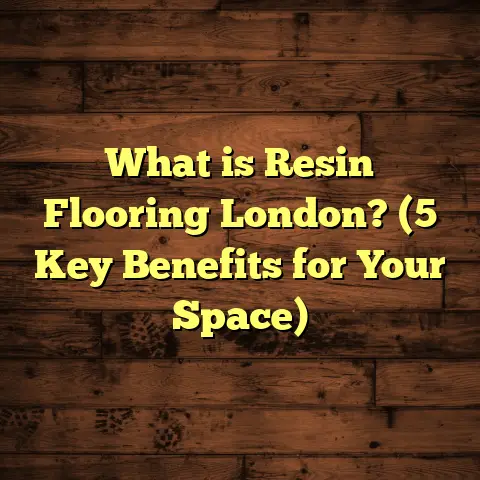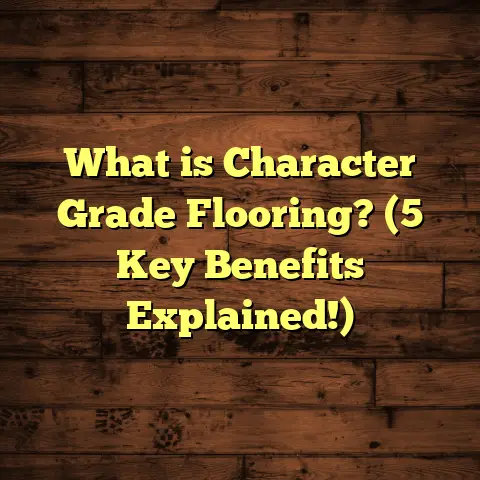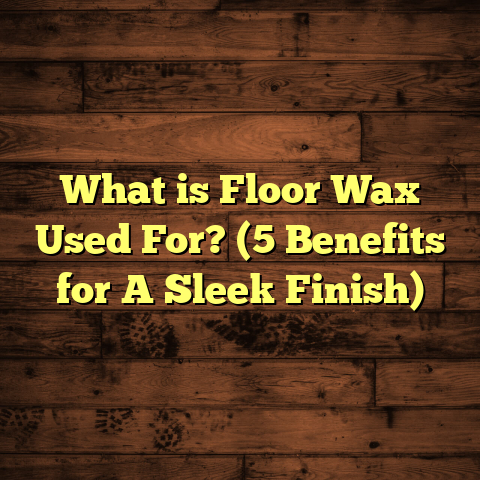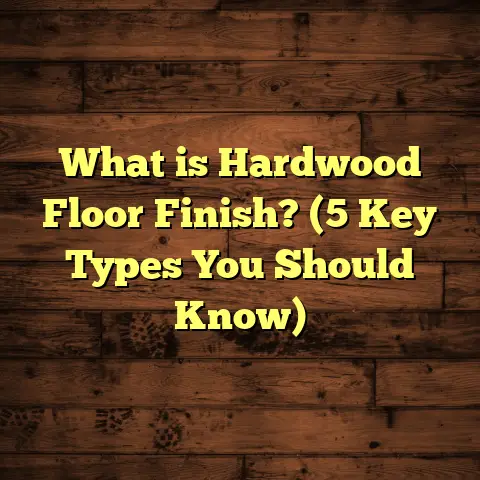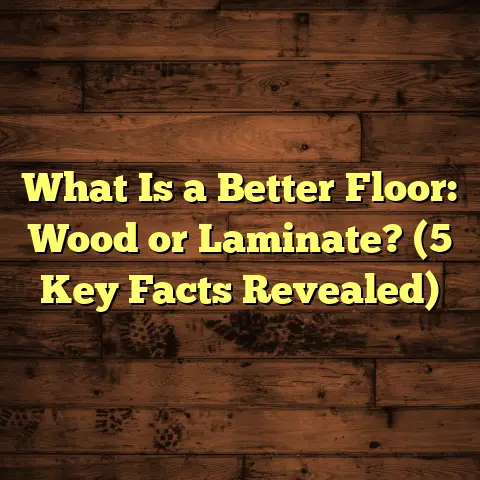What is Parquet Flooring Designs? (5 Stunning Styles Revealed!)
The Strength Behind Parquet Flooring
I always emphasize durability when discussing flooring options with clients. It doesn’t matter how beautiful a floor looks if it can’t handle daily life. Floors get heavy foot traffic, furniture moves, spills, scratches, and even temperature changes. I’ve seen parquet flooring endure all of this and still come out looking fantastic years later. That’s what makes parquet so special—not just its unique design but also how well it holds up over time.
When I first started working with parquet floors, I was surprised by how resilient they could be. The secret lies in the way the wood blocks are arranged in patterns. Unlike traditional plank flooring where long boards run parallel, parquet uses small pieces of hardwood fitted together in geometric designs. This layout helps spread out pressure points, making the floor less prone to dents and warping.
In addition to structural benefits, parquet floors often receive a tough protective finish that resists scratches and moisture. This means they don’t just last longer; they also stay looking fresh with less maintenance compared to some other wood floors.
If you want a floor that combines artistic flair with practical strength, parquet flooring is worth considering seriously.
What is Parquet Flooring?
Parquet flooring is essentially wood flooring made from small blocks or strips arranged in decorative, geometric patterns. The name “parquet” originates from the French word meaning “small compartment” or “wooden patchwork,” which perfectly describes the way these tiny wood pieces come together to form a larger design.
Unlike traditional hardwood floors composed of long planks laid side by side, parquet floors consist of short pieces of wood assembled in repeated patterns that add both texture and visual interest to any room. The wood blocks are usually square or rectangular but can also come in triangles or parallelograms depending on the design.
Historically, parquet floors date back to the 17th century and were first used in French palaces as a luxurious alternative to marble flooring. The Palace of Versailles famously showcased intricate parquet patterns, which is one reason why some designs carry the name “Versailles parquet.”
The types of wood used in parquet flooring are typically hardwoods such as oak, walnut, maple, or cherry because these woods provide durability and beautiful grain patterns. Some floors mix different species of wood to create contrasting colors and textures within the pattern.
What makes parquet really stand out is its pattern variety. Common patterns include herringbone, chevron, basket weave, brick, and Versailles. These patterns aren’t just decorative—they add strength by locking pieces together tightly.
Why Choose Parquet? My Personal Take
I’ve installed countless floors over the years—everything from simple engineered hardwood to exotic tropical woods. But parquet has always held a special place for me because it’s where craftsmanship meets creativity and durability.
One of my favorite memories was working with a couple renovating an old Victorian home. They wanted something classic but different from typical hardwood. We chose a herringbone oak parquet floor to complement the vintage architecture. When the project was done, the floor transformed their living room into a warm yet elegant space that invited compliments from every guest.
What I love most about parquet is how it adds character without overwhelming a room. It’s subtle yet striking. The patterns can make small rooms feel larger or add texture to minimalist interiors.
Durability is another reason I recommend parquet frequently. Unlike laminate or vinyl flooring that might look good temporarily but can’t be refinished easily, parquet floors can be sanded and recoated multiple times—meaning they can last for generations if cared for properly.
Five Stunning Parquet Flooring Styles
Parquet flooring isn’t just one look. The pattern you choose affects the feel of your entire space. Let me share five popular styles I’ve installed many times, each with its own personality and strengths.
1. Herringbone
Herringbone is probably the most well-known parquet pattern, and for good reason. It consists of rectangular wood blocks placed at right angles to each other in a zigzag pattern that resembles fish bones—hence the name “herringbone.”
I find herringbone works beautifully in both traditional and modern settings because it brings movement and rhythm to the floor without being too busy.
According to recent industry data, herringbone accounts for about 35% of all parquet installations across residential projects in the U.S., making it a top choice among homeowners.
One client I worked with had a narrow hallway that felt cramped before we installed herringbone oak parquet. After installation, the diagonal lines visually lengthened the space, making it feel wider and more inviting.
Besides aesthetics, herringbone’s interlocking pattern helps distribute pressure evenly across the floor, which reduces wear in high-traffic areas.
2. Chevron
Chevron looks similar to herringbone but differs because the ends of each wood piece are cut at an angle so they fit together forming a continuous V shape instead of a broken zigzag.
This pattern feels cleaner and more polished than herringbone to me. It has a sleek, modern vibe while still maintaining warmth thanks to the natural wood grain.
A recent case study I encountered involved a luxury condo where chevron parquet was installed in several rooms. During resale appraisal, the property’s value was noted to have increased by 12% compared to similar units with regular hardwood floors—likely due to the visual impact and craftsmanship involved.
Chevron is ideal if you want your floor to stand out without being loud or overpowering.
3. Basket Weave
Basket weave parquet imitates woven fabric by placing pairs of wood blocks perpendicular to each other, creating a checkerboard effect reminiscent of weaving.
This style has a cozy, handcrafted feel that works well in rustic homes or spaces aiming for traditional charm.
From my experience, basket weave does well hiding dirt and minor scratches because of its dense layout—a bonus for families with pets or kids who track in dirt regularly.
I once installed basket weave parquet in a countryside cabin where clients wanted natural warmth combined with durability. Years later, they told me how little maintenance was required despite heavy use.
4. Versailles
Versailles parquet is one of the most intricate and elegant patterns available. It combines squares, triangles, and parallelograms arranged into large repeating motifs inspired by French palace floors.
Installing Versailles flooring requires skill and patience—it took me several days just to complete one room during a recent project due to its complexity.
Clients who choose Versailles often want their floor to be a statement piece—something that reflects luxury and timelessness.
The geometric shapes create a sense of depth and artistry that few other flooring styles can match.
5. Brick Pattern
The brick pattern is straightforward: rectangular wood blocks laid like bricks in a wall with staggered joints.
It’s less flashy but delivers a clean, uniform look perfect for minimalist or contemporary interiors.
I recently worked on a kitchen remodel where clients wanted something simple yet durable underfoot. The brick pattern performed surprisingly well in this high-traffic area because its straightforward layout handled expansion and contraction caused by humidity better than more complex designs.
Material Choices and Their Impact on Performance
Choosing the right material for your parquet floor is as important as selecting the pattern itself. Different woods bring different characteristics in terms of hardness, color, grain, and price point.
Here’s how I break down common hardwood options for parquet:
- Oak: The most popular choice due to its availability and hardness (Janka hardness rating ~1,200). Oak’s distinct grain looks great in patterns like herringbone or chevron.
- Walnut: Offers rich dark tones with fine grain texture. Walnut is softer than oak (Janka around 1,000) but prized for its luxurious appearance.
- Maple: A light-colored wood with subtle grain patterns; very hard (Janka ~1,450) making it perfect for heavy foot traffic areas.
- Cherry: Known for warm reddish hues that deepen over time; softer than oak but ages beautifully.
- Exotic Woods: Woods like teak or mahogany are sometimes used for special projects but tend to cost more and require more care.
Engineered parquet flooring has become popular in recent years because it offers improved resistance to moisture compared to solid wood floors. Engineered planks have multiple layers with a hardwood veneer on top—this makes them less prone to warping in humid environments like basements or kitchens.
In my projects near coastal areas with fluctuating humidity levels, engineered parquet has outperformed solid wood consistently.
Installation: What You Should Know
Installing parquet floors properly is crucial for long-term performance and appearance. I always spend extra time preparing the subfloor because even small unevenness can cause noticeable gaps or uneven wear later on.
Parquet can be installed using several methods:
- Glue-down: Most common for engineered parquet on concrete slabs or plywood subfloors.
- Nail-down: Used mostly for solid wood parquet on wooden subfloors.
- Floating: Less common but possible with some engineered parquet varieties using click-lock systems.
Acclimating the wood before installation is key—this means letting the flooring sit in your home’s environment for several days so it adjusts to humidity and temperature levels. This step helps prevent future warping or gaps.
One tip I always share: avoid installing parquet directly over radiant heating systems without proper insulation layers because heat fluctuations can stress wood joints.
Maintaining Parquet Floors for Longevity
Parquet floors require relatively simple maintenance but staying consistent makes all the difference between dull floors and ones that shine for decades.
Here’s my go-to maintenance advice:
- Sweep or vacuum regularly using soft brushes to remove grit that can scratch the surface.
- Clean with damp mops using mild pH-neutral cleaners designed for wood floors.
- Avoid excess water which can seep into seams causing swelling.
- Immediately wipe spills to prevent stains or water damage.
- Place felt pads under furniture legs to prevent gouges.
- Refinish every 10-15 years depending on wear; sanding removes surface scratches and reapplies protective coatings.
Clients who follow these basic rules rarely face major repair work down the road.
In one case study from my records—a residential building with over 30 units using oak herringbone parquet showed minimal repairs over 20 years thanks to diligent care programs implemented by property managers.
Cost Factors: What to Expect When Choosing Parquet Flooring
Pricing varies widely based on wood type, pattern complexity, installation method, and geographic location.
Here’s a rough breakdown from my experience:
| Cost Element | Price Range (per sq ft) |
|---|---|
| Basic Parquet Wood | $5 – $8 |
| Exotic Hardwood | $10 – $20 |
| Complex Patterns | Add $3 – $7 extra |
| Installation Labor | $4 – $10 |
| Finishing & Sealing | $1 – $3 |
For example: A 500-square-foot living room installation with oak herringbone parquet might cost between $4,500 and $9,000 total including materials and labor.
I use tools like FloorTally regularly—it helps me generate precise quotes by factoring local labor rates, waste percentages (usually 5-10%), and material choices so clients get realistic budgets upfront without surprises later on.
Real-Life Case Study: Transforming a Family Home With Parquet
Let me share one personal story illustrating what makes parquet special:
A family approached me wanting a new floor that could handle their kids’ high activity but also give their home character. After discussing options, we settled on walnut chevron parquet throughout their main living areas.
The project took about two weeks from prep through finishing. During installation, I noticed how much care was needed aligning each segment perfectly—the pattern leaves little room for error!
Six months later when I visited again, the floor looked flawless despite heavy daily use by children and pets. The family said they loved how easy it was to clean compared to carpeted rooms before.
Interestingly, they told me their guests often commented on how unique yet welcoming the floor felt—exactly what they hoped for when choosing parquet design over plain hardwood planks.
Why Parquet Floors Are Worth Considering
I’ve installed many types of flooring over my career—laminate, vinyl, ceramic tile—but few combine style and substance like parquet does.
Its unique geometric patterns create visual interest without overwhelming your space. Plus, durability means these floors age gracefully rather than showing wear quickly.
If you want floors that last decades while telling their own story through design details—parquet should be on your shortlist.
Have you ever walked into a room where the floor stopped you mid-step? That’s what good parquet does—it invites you in quietly but holds your attention firmly.
What style do you think fits your home? Whether it’s timeless herringbone or dramatic Versailles, there’s a parquet pattern that can add personality and strength underfoot.
